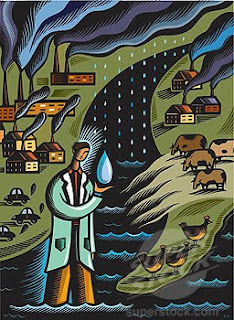 Pollution in Water may be analyzed through several broad categories of methods: physical, chemical and biological. Most methods involve collection of samples, followed by specialized analytical tests. Some methods may be conducted in situ, without sampling, such as temperature. Government
Pollution in Water may be analyzed through several broad categories of methods: physical, chemical and biological. Most methods involve collection of samples, followed by specialized analytical tests. Some methods may be conducted in situ, without sampling, such as temperature. Governmentagencies and research organizations have published standardized, validated analytical test methods to facilitate the comparability of results from disparate testing events.
1- Sampling
Sampling of water for physical or chemical testing can be done by several methods, depending on the accuracy needed and the characteristics of the contaminant. Many contamination
events are sharply restricted in time, most commonly in association with rain events. For this reason "grab" samples are often inadequate for fully quantifying contaminant levels. Scientists gathering this type of data often employ auto-sampler devices that pump increments of water at either time or discharge intervals. Sampling for biological testing involves collection of plants and/or animals from the surface water body. Depending on the type of assessment, the organisms may be identified for biosurveys (population counts) and returned to the water body, or they may be dissected for bioassays to determine toxicity.
2-Physical testing
Common physical tests of water include temperature, solids concentration and turbidity.
3- Chemical testing
Water samples may be examined using the principles of analytical chemistry. Many published test methods are available for both organic and inorganic compounds. Frequently-used methods include pH, biochemical oxygen demand (BOD), chemical oxygen demand (COD), nutrients (nitrate and phosphorus compounds), metals (including copper, zinc, cadmium, lead and mercury), oil and grease, total petroleum hydrocarbons (TPH), and pesticides.
4- Biological testing
Biological testing involves the use of plant, animal, and/or microbial indicators to monitor the health of an aquatic ecosystem. Bacteriological water analysis is a method of analyzing water to estimate the numbers of bacteria present and, if needed, to find out what sort of bacteria they are. It is a microbiological analytical procedure which uses samples of water and from these samples determines the concentration of bacteria. It is then possible to draw inferences about the suitability of the water for use from these concentrations. This process is used, for example, to routinely confirm that water is safe for human consumption or that bathing and recreational waters are safe to use. The interpretation and the action trigger levels for different waters vary depending on the use made of the water. Very stringent levels applying to drinking water whilst more relaxed levels apply to marine bathing waters where much lower volumes of water are expected to be ingested by users.
2 comments:
女傭調教 女生自衛 夫妻交換 大腿內側 夜未眠成 嘟嘟情人 嘟嘟圖片 同志色教 吉澤明步 台中夜店 台北夜店 台灣同志 台灣ki 出包王女 凹凸電影 凌虐俠女 免費女同 免費女傭 免費圖片 免費同志 免費動畫 免費黃色 免費貼影 免費色片 免費dv 免費線上 -qq美美 jp素人 h文小說 辣媽寫真 辣媽哺乳 黃色珍藏 麗的線上 貼圖片區 高雄夜店 視訊kk 西洋美女 電影線上 阿賓小說 阿賓色慾 蓬萊仙山 色片直播 美女自衛 美國色片 美美色網 線上收看 線上動畫 素人寫真 素人大全 短片線上
nice job! waiting for your new artical. .................................................................
Post a Comment